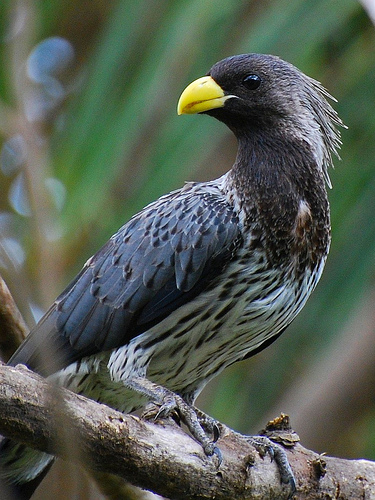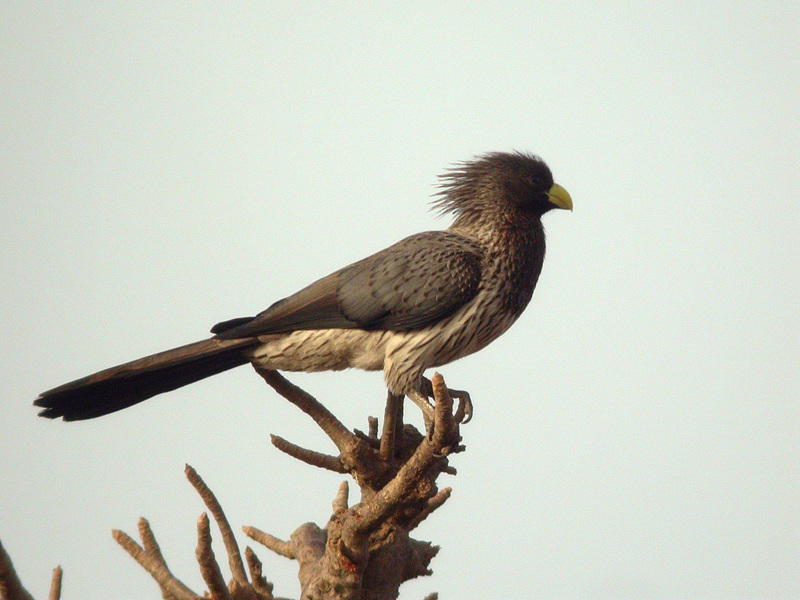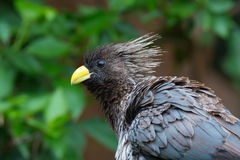
Crinifer piscator
SUBFAMILY
Criniferinae
TAXONOMY
Falco piscator Boddaert, 1783, Senegal. Monotypic.
OTHER COMMON NAMES
English: Gray plantain-eater; French: Touraco gris; German:
Schwarzschwanz-Larmvogel; Spanish: Turaco Gris Occidental.
PHYSICAL CHARACTERISTICS
19–20 in (48–51 cm); 11.6–12.3 oz (330–350 g). A predominantly
gray-and-white turaco with a large lemon-yellow bill.
Adults have forehead, crown, lores, cheeks, chin, and throat
dark brown. A shaggy dark brown nape crest with whitish edges
is unique among turacos. Upperparts silvery gray with dark
brown spots; the lower breast, belly, flanks, thighs, and under
tail coverts are white with heavy brown streaking, particularly
on the thighs. Primary feathers black with a central third of the
inner webs white, forming a conspicuous white wing patch in
flight; tail largely blackish brown. Juveniles less silvery gray on
upperparts and lack any crest on an otherwise all dark head.
DISTRIBUTION
Widespread throughout the sub-Saharan acacia steppe, wooded
savannas, and cultivation from southern Mauritania, Senegambia,
Guinea, and Sierra Leone east to Nigeria, Cameroon,
Lake Chad, and the Central African Republic. Also disjunctly
along the Congo River south of Stanley Pool.
HABITAT
Typically from sea level to 4,225 ft (1,300 m) in open wooded
savannas and thorn scrub with scattered tall trees, while in the
more semi-arid areas it keeps mainly to the thicker stands of
vegetation and riparian woods. In many areas has adapted to
cultivation and the neighborhood of villages, particularly where
favored fruiting trees are available. Has readily adapted to
parks and gardens in many countries.
BEHAVIOR
A gregarious species, occurring generally in pairs or small
groups. Always a noisy bird, with one seldom perching or joining
its mate without a great deal of commotion. Pair bonding
is exceptionally strong, with much calling, bowing, tail fanning,
and food exchanges taking place during all greeting displays.
Courtship display flights are always noisy and impressive. Less
agile in running along branches than other turacos, as a result
tends to fly more, albeit for short distances with much gliding
alternating with rapid wingbeats. Frequently comes to ground
to drink.
FEEDING ECOLOGY AND DIET
A wide variety of wild and cultivated fruits are eaten, together
with flowers, seed pods, and invertebrates, while the name
plantain-eater is erroneous. Flowers constitute a major part of
the diet, possibly as high as 50% in some individuals. Favored
fruits include figs, mangos, and guavas, also the wild date
(Phoenix reclinata), oil palm fruits (Elaeis guineensis), and the
widely introduced neem (Azadirachta indica).
REPRODUCTIVE BIOLOGY
Generally two grayish white or pale bluish white eggs, oval and
slightly glossy, are laid in a fairly substantial platform of dry
sticks some 12–50 ft (4–15 m) above ground in a leafy tree. Incubation
is by both sexes for 27–28 days, and on hatching the
young are covered in grayish-brown down. Fledging period for
this species unrecorded.
CONSERVATION STATUS
Not globally threatened, being widespread and locally abundant
over much of the West African savannas, reaching a density
of one bird per 2.5 acres (per hectare) in some areas of
Acacia scorpioides woodland in Senegal. Commonly hunted and
trapped for export in several countries, most notably Guinea.
SIGNIFICANCE TO HUMANS
A highly sought after species in the traditional fetish markets
of Nigeria.
Photo Gallery of - Western gray plantain-eater




 Animalia Life
Animalia Life